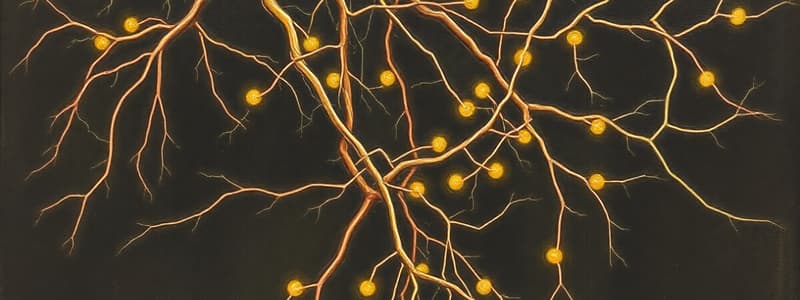Podcast
Questions and Answers
What is the primary role of motor neurones in the human nervous system?
What is the primary role of motor neurones in the human nervous system?
- Provide insulation to axons
- Link sensory and motor neurones
- Carry impulses from the CNS to effectors (correct)
- Transmit impulses to sensory receptors
All neurones have a myelin sheath.
All neurones have a myelin sheath.
False (B)
What is the purpose of relay neurones in the CNS?
What is the purpose of relay neurones in the CNS?
To link sensory and motor neurones directly for rapid reflex responses.
Sensory neurones carry impulses from sensory receptors to the ______.
Sensory neurones carry impulses from sensory receptors to the ______.
Match the type of neurone with its function.
Match the type of neurone with its function.
What are the basic components found in all neurones?
What are the basic components found in all neurones?
Explain the role of myelin sheath in motor neurones.
Explain the role of myelin sheath in motor neurones.
Identify the location of the cell body in a motor neuron.
Identify the location of the cell body in a motor neuron.
How do relay neurones contribute to reflex actions?
How do relay neurones contribute to reflex actions?
Describe the difference between sensory and motor neurones in terms of their function.
Describe the difference between sensory and motor neurones in terms of their function.
Flashcards
Neuron function
Neuron function
Neurons transmit information throughout the human nervous system.
Neuron structure
Neuron structure
All neurons have a cell body, dendrites, an axon, and synapses.
Motor neuron characteristic
Motor neuron characteristic
Motor neurons carry impulses from the CNS to muscles and glands.
Relay neuron function
Relay neuron function
Signup and view all the flashcards
Sensory vs. Motor Neuron difference
Sensory vs. Motor Neuron difference
Signup and view all the flashcards
What are neurones?
What are neurones?
Signup and view all the flashcards
What are dendrites?
What are dendrites?
Signup and view all the flashcards
What is an axon?
What is an axon?
Signup and view all the flashcards
What is a synapse?
What is a synapse?
Signup and view all the flashcards
What is a relay neuron?
What is a relay neuron?
Signup and view all the flashcards
Study Notes
Neurones
- Neurones are the basic units of the human nervous system
- They have a cell body, dendrites, axon, and synapses
- Many neurones also have a myelin sheath (insulation)
- Sensory neurones carry impulses from sensory receptors to the CNS
- Motor neurones carry impulses from the CNS to effectors (muscles and glands)
- Relay neurones connect sensory and motor neurones within the CNS
- Nerves are bundles of hundreds or thousands of neurones
Motor Neurones
- Carry electrical impulses from the central nervous system (CNS) to effector organs (muscles and glands)
- Their cell bodies are located in the CNS
- The axon extends from the CNS to the effector organ
- The axon is often myelinated for faster impulse transmission
- Impulses travel along the axon and across synapses to activate the effector organ
Relay Neurones
- Located within the CNS
- Connect sensory and motor neurones
- Crucial for processing information
Structure of a Neuron
- Cell body: Contains the nucleus and other organelles
- Dendrites: Branch-like structures that receive signals from other neurones
- Axon: A long, thin fibre that transmits signals away from the cell body
- Myelin sheath: A fatty layer that insulates the axon and speeds up signal transmission
- Synapse: The junction between two neurones where signals are transmitted
Studying That Suits You
Use AI to generate personalized quizzes and flashcards to suit your learning preferences.




